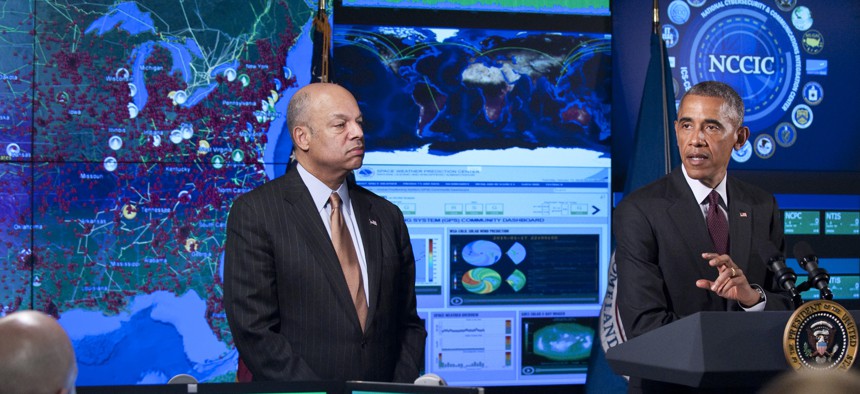
Secretary of Homeland Security Jeh Johnson hosts President Obama at the National Cybersecurity and Communications Integration Center, Jan. 13, 2015. Official DHS photo by Barry Bahler
US Homeland Security's $6B Firewall Has More Than a Few Frightening Blind Spots
A recent audit revealed the National Cybersecurity Protection System—aka EINSTEIN—does not scan for 94 percent of common computer vulnerabilities. But that's not all of its shortcomings.
A firewall run by the Department of Homeland Security meant to detect and prevent nation-state hacks against the government functions ineffectively, according to a sanitized version of a secret federal audit.
EINSTEIN relies on patterns of attacks, called signatures, to spot suspicious traffic, but it does not scan for 94 percent of commonly known vulnerabilities or check web traffic for malicious content.
Those are two of the many failings uncovered in a damning public version of a "for official use only" Government Accountability Office report. In addition, the prevention feature of the system is only deployed at five of the 23 major nondefense agencies.
Lawmakers in November 2015 suggested the then-confidential audit of EINSTEIN, formally called the National Cybersecurity Protection System, or NCPS, would prove the hacker surveillance system is not governmentwide.
The newly released audit corroborates their views and points out other misaligned objectives and technologies in a $6 billion project DHS cannot say helps combat hackers, according to auditors.
"Until NCPS’ intended capabilities are more fully developed, DHS will be hampered in its abilities to provide effective cybersecurity-related support to federal agencies," GAO director of information security issues, Gregory C. Wilshusen, and Nabajyoti Barkakati, director of the GAO Center for Technology and Engineering, said in the audit, which was released Thursday.
The auditors focused their study on the departments of Energy and Veterans Affairs, as well as the General Services Administration, the National Science Foundation and the Nuclear Regulatory Commission.
Does Not Cover Nation-State ‘Advanced Persistent Threats’
“The overall intent of the system was to protect against nation-state level threat actors," according to the audit, yet EINSTEIN missed so-called advanced persistent threats.
Such attacks are a common tactic among foreign adversaries, in which a well-resourced group obtains a foothold in part of a target's system and lingers invisibly for months at a time until achieving its mission.
EINSTEIN "did not possess intrusion detection signatures that fully addressed all the advanced persistent threats we reviewed," the authors said.
In response to a draft report, DHS officials said EINSTEIN is only one technology of many that each department uses to protect its sensitive data. It is the job of the individual agency to keep its IT and data safe, while Homeland Security’s role is confined to providing baseline protections and a big-picture perspective of security controls governmenwide, they said.
EINSTEIN works by pushing out signatures of known attack patterns to 228 intrusion-detection sensors placed throughout the dot-gov network. The sensors analyze patterns in agency traffic flows to see if they match any of the signatures.
EINSTEIN Doesn’t Know Common Security Vulnerabilities
But the signatures "do not address threats that exploit many common security vulnerabilities and thus may be less effective," the auditors said.
The quality of EINSTEIN hinges on the quality of its vulnerability signatures.
"However, the signatures supporting NCPS’s intrusion detection capability only identify a portion of vulnerabilities associated with common software applications," the authors reported.
Of five client applications reviewed -- Adobe Acrobat, Flash, Internet Explorer, Java and Microsoft Office -- the system was able to flag, to some extent, only 6 percent of all the security bugs tested. That's 29 out of 489 vulnerabilities.
One reason for the blind spots, according to the auditors, is that EINSTEIN does not sync with the standard national database of security flaws maintained by the National Institute of Standards and Technology.
Homeland Security officials said they weren’t required to link up the signatures with the vulnerability database when EINSTEIN was first developed. DHS "has acknowledged this deficiency" and plans to address it in the future, according to the audit.
No Way to Spot Unknown Zero Days until ‘Announced’
The espionage artists behind a background check hack at the Office of Personnel Management busted through EINSTEIN's defenses with malware DHS admits the system cannot handle. The assailants, allegedly backed by China, wielded "zero day" exploits that are not publicly known and certainly not published as signatures.
"Regarding zero day exploits," Homeland Security officials stated "there is no way to identify them until they are announced," the report states. Once they are disclosed, DHS can mold a signature to the attack pattern and feed it into EINSTEIN.
Sometimes, intelligence community partners will notify DHS about zero day exploits before they are publicly revealed, and those exploits are usually malware, according to the audit. DHS officials told the auditors that Homeland Security does not pay for zero days.
EINSTEIN can prevent intrusions in almost-real time within certain data flows. Still, there are key network flows the system can't see. For example, the system can block malicious "domain name system" servers and filter emails, but “there are other types of network traffic (e.g., web content), which are common vectors of attack not currently being analyzed for potentially malicious content," the authors said.
Information Sharing Is Often A Waste
DHS is working to overcome technological and policy issues that have stymied activation of intrusion-prevention features at 5 of the 23 agencies, GAO officials said. The IT infrastructures at each agency differ and EINSTEIN must be tailored to each setup. In addition, not all agencies meet the security specifications for EINSTEIN to perform properly. In general, agencies are concerned about the system disrupting mission-critical applications, like email.
Information sharing is another goal of EINSTEIN in need of attention, according to the review.
"DHS’s sharing of information with agencies has not always been effective, with disagreement among agencies about the number of notifications sent and received and their usefulness," the GAO auditors said.
The agencies reviewed did not receive 24 percent of the notifications Homeland Security said it had sent in fiscal 2014. The ones that did reach IT personnel often served no purpose, according to the audit. Of the 56 alerts communicated successfully, 31 were timely and useful, while the rest were too slow, useless, false alarms or unrelated to intrusion detection.
Meanwhile, DHS has created a variety of metrics related to EINSTEIN. “None provide insight into the value derived from the functions of the system," the auditors said.




